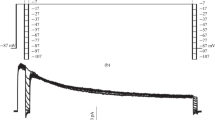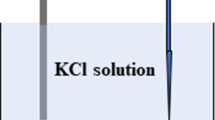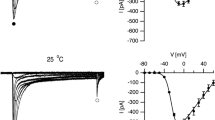Abstract
Outward currents in isolated, internally-perfused snail neurons were slowed and reduced in amplitude by replacement of external K with Na, Cs, or tris. This behavior is not predicted by electrodiffusion theory, but can be described by a second-order kinetic model. The effect of potassium replacement is to reduce the rate constant for channel opening by aout 25% without affecting the rate constant for channel closing. The open channels may be stabilized by external potassium ions, thus increasing the mean channel open time.
Similar content being viewed by others
References
Århem, P. (1980). Effects of rubidium, cesium, strontium, barium and lanthanum on ionic currents in myelinated nerve fibers fromXenopus laevis, Acta Physiol. Scand. 108, 7–16.
Ciani, S., Krasne, S., Miyazaki, S., Hagiwara, S. (1978). A model for anomalous rectification: Electrochemical-potential-dependent gating of membrane channels,J. Memb. Biol. 44, 103–134
Connor, J.A., Stevens, C.F. (1971). Voltage clamp studies of a transient outward membrane current in gastropod neural somata,J. Physiol.213, 21–30.
Dubois, J.M., Bergman, C. (1977). The steadystate potassium conductance of the Ranvier node at various external K-concentrations,Pflügers Arch. 370, 185–194.
Eckert, R., Tillotson, D. (1978). Potassium activation associated with intraneuronal free calcium,Science 200, 437–439.
Frankenhaeuser, B. (1962). Delayed currents in myelinated nerve fibres ofXenopus laevis investigated with voltage clamp technique,J. Physiol. 160, 40–45.
Gage, P.W., Van Helden, D. (1979). Effects of permeant monovalent cations on end-plate channels,J. Physiol. 288, 509–528.
Hodgkin, A.L., Huxley, A.F. (1952). A quantitative description of membrane current and its application to conduction and excitation in nerve,J. Physiol. 117, 500–544.
Kerkut, G.A., Thomas, R.C. (1965). An electrogenic sodium pump in snail nerve cells,Comp. Biochem. Physiol. 14, 167–183.
Lee, K.S., Akaike, N., Brown, A.M. (1978). Properties of internally perfused, voltage-clamped, isolated nerve cell bodies,J. Gen. Physiol. 71, 489–507
Meech, R.W., Standen, N.B. (1975). Potassium activation inHelix aspersa neurons under voltage clamp: A component mediated by calcium influx,J. Physiol. 249, 211–239.
Neher, E. (1971). Two fast transient current components during voltage clamp on snail neurons,J. Gen. Physiol. 58, 36–53.
Neher, E., Lux, H.D. (1971). Properties of somatic membrane patches of snail neurons under voltage clamp,Pflügers Arch. 322, 35–38.
Reuter, H., Stevens, C.F. (1980). Ion conductance and ion selectivity of potassium channels in snail neurons,J. Memb. Biol. 57, 103–118.
Swenson, R.P., Armstrong, C.M. (1981). K+ channels close more slowly in the presence of external K+ and Rb+,Nature 291, 427–429.
Author information
Authors and Affiliations
Rights and permissions
About this article
Cite this article
Junge, D. External K+ ions increase rate of opening of outward current channels in snail neurons. Pflugers Arch. 394, 94–96 (1982). https://doi.org/10.1007/BF01108314
Received:
Accepted:
Issue Date:
DOI: https://doi.org/10.1007/BF01108314




